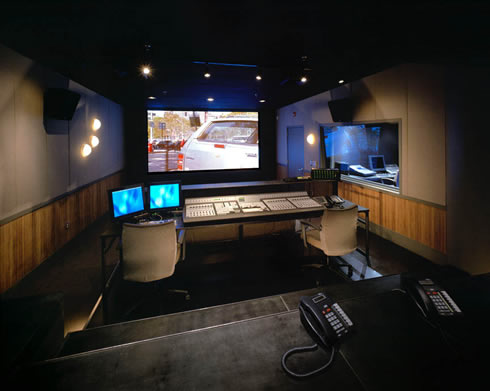Dig It Audio digs Chevin amplifiers,
low distortion in new studio
By Toni Flosi
Dateline: When Dig It Audio needed to add a new film sound mixing room to their complex, they called on veteran sound master Ted Rothstein to specify and install the video and audio monitoring components. Located in the Soho neighborhood of New York, Dig It Audio's multiple mix rooms and Foley stage endear clients by delivering technical excellence in uncommonly comfortable surroundings. To their credit are such films as Trans, Happiness, and High Art along with commercials for Ben and Jerry's Ice Cream and the Connecticut Lotto (among many, many others). The new studio had to match or exceed their already high expectations! Rothstein is principle at TR Technologies, also located in New York, and has "electro-acoustically jump started" the studios of such luminaries as Roger Waters (UK), Patrick Leonard (LA), and Van Halen (LA). He was more than up to the challenge.
Save for the limitations of space, Rothstein was free to incorporate whatever elements he felt were necessary to deliver accurate monitoring, and his credits include defining the optimal room geometry. On the video end of things, he installed a Sharp XV-Z9000 projector and a 182-inch by 91-inch Stewart Filmscreen Cine-Perf screen. He masked the screen down to a 134-inch by 75-inch for the perfect size and aspect ratio.
He installed the larger screen to match the JBL 3-way 3632-T cinema series loudspeakers, which are arranged in a left, center, right, and sub configuration at 182-inches by 91-inches. Several BSS 9088 Soundwebs handle all of the processing and crossovers. To accommodate different projects and different needs, Rothstein set up five equalization presets, the "X" cinematic curve, the "academy" cinematic curve, a "flat" reference and setup curve, and two music-mixing curves developed through Rothstein's work with Waters and Van Halen. He noted that multi-curve monitoring systems help the film and music worlds converge.

A strict adherent of bi-, tri-, and (in this case) quad-amplification,
Rothstein brought in sixteen channels of 600-watt (at 4‡) Chevin
amplification via four Chevin Q6's. Noting the proliferation of amplifiers
on the market, Rothstein discussed why he chose Chevin: "First
and foremost, they simply sound great. Why do they sound so good? The
main reason is their very fast slew rate, in excess of 75-volts per
microsecond. That means that the amplifier can accurately track high
frequency signals without transient intermodulation distortion (TIM).
Very few manufacturers maximize their slew rate - Chevin is among the
very best.
"I also appreciate their reliability," he continued.
"Having performed hundreds of permanent installations all around
the world, I need to know my systems will not only sound great when
I commission them, but will continue to sound great years later with
minimal maintenance. Chevin also allows me to keep amplifier level settings
at their correct position, optimizing gain structure and overall performance."
In addition to excellent specifications and reliability, the Q6's also
boast a relatively small size, conserving precious real estate.
By quad-amplifying the JBL's, Rothstein further improves the sound by
reducing steady-state intermodulation distortion (IM) in both the amplifiers
and the loudspeakers. By actively quad-amplifying, no amplifier is asked
to simultaneously reproduce 20kHz wiggles on top of 50Hz waves.
For all his careful design and implementation, the new Dig It Audio studio is more that the client hoped for. Low distortion and accurate amplification yields good, solid sound, and Dig It Audio is now steeped in the first project in their new studio.